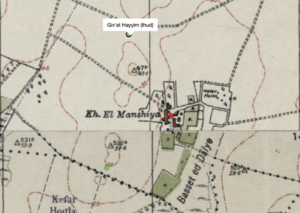“Jewish villages were built in the place of Arab villages. You do not even know the names of these Arab villages, and I do not blame you because geography books no longer exist, not only do the books not exist, the Arab villages are not there either. Nahlal arose in the place of Mahlul; Kibbutz Gvat in the place of Jibta; Kibbutz Sarid in the place of Huneifis; and Kefar Yehushu’a in the place of Tal al-Shuman. There is not one single place built in this country that did not have a former Arab population.”
– Israeli Defense Minister Moshe Dayan, speech at Haifa Technion, April 4, 1969, cited by Haaretz
One could add another mention to Dayan’s list – kibbutz Givat Haim Ichud was built in the place of Khirbet el-Manshiyya.
I was born on that kibbutz, in central Israel, in 1972.

Givat Haim literally means ‘Hill of life’ in Hebrew. It was named after Haim Arlosoroff, a Jewish Agency official who was murdered in 1933 in Tel Aviv, probably by Revisionist Zionists (from Abba Ahimeir’s Brit Habiryonim, or ‘Covenant of the Thugs’, a sub-group of Jabotinsky’s Revisionists). Arlosoroff had just returned from Nazi Germany, having negotiated with the Nazis a deal called the Transfer Agreement, whereby mostly wealthy German Jews could deposit money with which agricultural equipment would be bought in Palestine, and they would move to Palestine. The deal served Nazi goals of getting rid of Jews, but also, importantly, breaking the anti-Nazi boycott from earlier that year.
In any case, this was inter-Zionist fighting and killing. But Arlosoroff was a Labor Zionist and represented the movement with which most kibbutzim were affiliated. So the first Givat Haim came to be named after him in 1933. I don’t know how many people in the kibbutz actually know this history. The more popular understanding of the name “Haim” in the title is its simple meaning in Hebrew – life. So, Givat Haim was understood as the “hill of life.”
In my youth and many years later, I knew pretty much nothing about the history of the place – a history that was directly tied up with the Nakba. My awakening as far as Palestine was concerned was in 2007 when I read Ilan Pappe’s seminal The Ethnic Cleansing of Palestine. It was a moment of shock, and I started wondering, what else have I missed? But even then I did not really wonder how my childhood kibbutz was tied to the Nakba. I just took in the greater narrative of the destruction and was shocked by my ignorance. But after some years, I would trace the Nakba more specifically to where I was born and grew up. I don’t know why I didn’t do it immediately – was I afraid to know? Was it getting too close for comfort?

